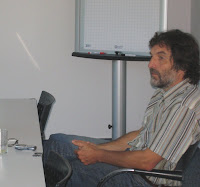Finland is one country in Europe were it seems pretty hard to get to in the morning from Germany or Austria. If you have a meeting before 11 am you have to fly the day before.
 I was invited to Helsinki to be opponent (together with Kaisa Väänänen-Vainio-Mattila) for the PhD defense of Elina Vartiainen at Helsinki University of Technology. The first time I came across work she was involved in was at CHI 2006 in Montreal. She worked with Virpi Roto on the Minimap web browser [1]. Last year in a doctoral colloquium in Finland we first discussed some of her work and I was excited to read it in more detail for the PhD exam.
I was invited to Helsinki to be opponent (together with Kaisa Väänänen-Vainio-Mattila) for the PhD defense of Elina Vartiainen at Helsinki University of Technology. The first time I came across work she was involved in was at CHI 2006 in Montreal. She worked with Virpi Roto on the Minimap web browser [1]. Last year in a doctoral colloquium in Finland we first discussed some of her work and I was excited to read it in more detail for the PhD exam.
 Dissertations in practical areas of computer science that are done in company research labs are at the same time limited and exciting. What can be done is often limited by the company needs but on the other hand it offers the great opportunity to get things out large scale and collect experiences from many users (e.g. you may want to check the ImageExchange project, where the studies were also part of Elina’s dissertation).
Dissertations in practical areas of computer science that are done in company research labs are at the same time limited and exciting. What can be done is often limited by the company needs but on the other hand it offers the great opportunity to get things out large scale and collect experiences from many users (e.g. you may want to check the ImageExchange project, where the studies were also part of Elina’s dissertation).
I like the finnish system of having a long public defense. We discussed about 3 hours with Elina and I enjoyed it 🙂
There are two general but important issues I think I take away from our discussion:
- do question the research process including the steps (e.g. hardware first or applications first), the approach (e.g. human need centred vs. design driven) and the setup of the teams (who is needed to get a successful product? Business, law, design, hardware?).
- innovation for web services on a global scale comes not from a single company or small set of highly skilled developers. Creating opportunities for a larger number developers (with skills limited skills, e.g. like web development) will be the key to create all the applications people need all over the world. Having a single instance controlling what can be developed does scale.
 Guess what was the first web browser on a mobile device I used on a mobile device? It was an Apple Messagepad – and the browser was PocketWeb developed at TecO in Karlsruhe (where I worked from 1998-2001), see [2] and http://www.teco.edu/pocketweb/
Guess what was the first web browser on a mobile device I used on a mobile device? It was an Apple Messagepad – and the browser was PocketWeb developed at TecO in Karlsruhe (where I worked from 1998-2001), see [2] and http://www.teco.edu/pocketweb/
[1] Roto, V., Popescu, A., Koivisto, A., and Vartiainen, E. 2006. Minimap: a web page visualization method for mobile phones. In Proceedings of the SIGCHI Conference on Human Factors in Computing Systems (Montréal, Québec, Canada, April 22 – 27, 2006). R. Grinter, T. Rodden, P. Aoki, E. Cutrell, R. Jeffries, and G. Olson, Eds. CHI ’06. ACM, New York, NY, 35-44. DOI= http://doi.acm.org/10.1145/1124772.1124779
[2] Stefan Gessler and Andreas Kotulla. PDAs as mobile WWW browsers. Proceedings of the Second World Wide Web Conference ’94: Mosaic and the Web. Chicago, Illinois, USA, 1994.

